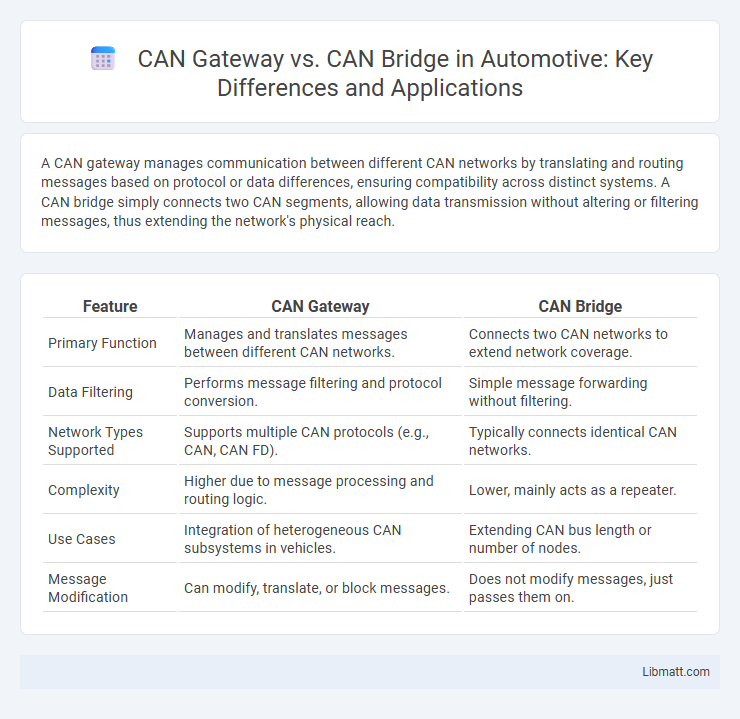A CAN gateway manages communication between different CAN networks by translating and routing messages based on protocol or data differences, ensuring compatibility across distinct systems. A CAN bridge simply connects two CAN segments, allowing data transmission without altering or filtering messages, thus extending the network's physical reach.
Table of Comparison
| Feature | CAN Gateway | CAN Bridge |
|---|---|---|
| Primary Function | Manages and translates messages between different CAN networks. | Connects two CAN networks to extend network coverage. |
| Data Filtering | Performs message filtering and protocol conversion. | Simple message forwarding without filtering. |
| Network Types Supported | Supports multiple CAN protocols (e.g., CAN, CAN FD). | Typically connects identical CAN networks. |
| Complexity | Higher due to message processing and routing logic. | Lower, mainly acts as a repeater. |
| Use Cases | Integration of heterogeneous CAN subsystems in vehicles. | Extending CAN bus length or number of nodes. |
| Message Modification | Can modify, translate, or block messages. | Does not modify messages, just passes them on. |
Introduction to CAN Gateway and CAN Bridge
CAN Gateway facilitates communication between multiple CAN networks with differing protocols or speeds, enabling seamless data translation and routing across automotive or industrial systems. CAN Bridge connects two CAN segments at the same protocol and speed, extending network length while maintaining data transparency without altering message content. Both devices play crucial roles in enhancing CAN network scalability and interoperability, but their applications differ based on protocol compatibility and data processing requirements.
Understanding the CAN Protocol
The CAN gateway and CAN bridge are essential components in managing communication within Controller Area Network (CAN) systems, which use the CAN Protocol to enable robust, real-time data exchange between microcontrollers and devices. A CAN gateway facilitates communication between different CAN networks by translating protocols or filtering messages, ensuring interoperability across diverse CAN systems. In contrast, a CAN bridge directly connects two CAN segments, forwarding all messages without modification, thus extending the network while maintaining protocol consistency.
What is a CAN Gateway?
A CAN gateway is a device that connects multiple Controller Area Network (CAN) buses with different protocols or data rates, enabling communication and data exchange between otherwise incompatible networks. It translates and routes messages between these CAN segments, ensuring seamless interoperability across various vehicle systems or industrial applications. Your system benefits from increased flexibility and integration capabilities through the use of a CAN gateway.
What is a CAN Bridge?
A CAN bridge is a network device that connects two or more CAN (Controller Area Network) segments, enabling communication between different CAN networks while maintaining data integrity. It operates at the data link layer, filtering and forwarding CAN frames based on identifiers to optimize traffic flow and reduce bus load. Your system benefits from a CAN bridge by extending network reach and improving segmentation without the complexity of full protocol translation.
Key Differences Between CAN Gateway and CAN Bridge
CAN Gateway translates and routes messages between different CAN protocols or networks, enabling communication across varied automotive or industrial systems. CAN Bridge simply connects two CAN segments to extend network length or improve signal quality without altering message content. Your choice depends on whether you need protocol conversion and message filtering (CAN Gateway) or straightforward network extension (CAN Bridge).
Common Applications of CAN Gateways
CAN gateways are widely used in automotive networks to enable communication between different CAN protocols or domains, such as linking powertrain and body control modules. They facilitate data translation and routing for multi-network integration, improving system interoperability and diagnostics. Typical applications include hybrid vehicle systems, advanced driver-assistance systems (ADAS), and industrial automation where diverse CAN networks must seamlessly exchange information.
Typical Uses for CAN Bridges
CAN bridges are typically used to connect multiple CAN networks or segments, enabling communication across different bus systems without merging their traffic. They help isolate fault domains and extend network size by selectively forwarding messages between segments based on identifiers. Your system benefits from CAN bridges when managing complex vehicle or industrial automation architectures requiring segmented yet interoperable communication channels.
Advantages of Using CAN Gateway
CAN gateway enhances network efficiency by enabling communication between different CAN protocols or network segments, reducing system complexity and improving data flow. It supports message filtering and protocol conversion, which minimizes bus load and prevents network congestion. Your automotive or industrial applications benefit from increased scalability and interoperability through the advanced features of a CAN gateway.
Benefits of CAN Bridge in Automotive Networks
CAN bridge enhances automotive networks by enabling efficient communication between multiple CAN buses, increasing data flow without overloading a single network segment. Your vehicle's electronic control units (ECUs) benefit from improved message filtering and routing, reducing latency and minimizing message collisions. This leads to more reliable diagnostics and control functions, crucial for advanced driver-assistance systems (ADAS) and vehicle stability control.
Choosing Between CAN Gateway and CAN Bridge
Choosing between a CAN gateway and a CAN bridge depends on the network architecture and communication needs. A CAN gateway enables protocol translation and communication between different CAN networks or layers, facilitating data exchange and integration across varied systems. In contrast, a CAN bridge simply connects two CAN segments to extend network reach while maintaining the same protocol and data format, ideal for enhancing network size without complexity.
CAN gateway vs CAN bridge Infographic

 libmatt.com
libmatt.com